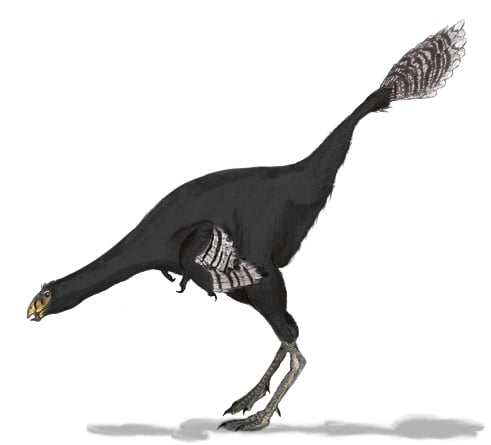
Welcome to another edition of "Friday's Elk." I'm sending out this newsletter every other week, barring deadlines and such. It'll stay free, but any support will be much appreciated!
Jurassic Ostrich?
Scientists who study the origin of birds in 2024 live in a different world than those who were studying it in 1994. In 1996, paleontologists in China announced the discovery of the first dinosaur with primitive feathers. Then more fossils came to light, some with more bird-like feathers. There were dinosaurs with stripes of colors across their plumage. They sported feathery tails, even feathery legs.

And yet the debates about the origin of birds have not gone quiet.
The fossils discovered so far indicate that dinosaurs evolved feathers at least 200 million years ago. Their feathers were too primitive and sparse for flight, and their arms could not generate a wingstroke. Instead the dinosaurs probably used their feathers to insulate their body heat or to show off fancy colors during courtship.
In 2020, Michael Pittman of the Chinese University of Hong Kong and his colleagues analyzed the shape of bones in birds and feathered dinosaurs. Based on that comparison, they argued that three lineages of feathered dinosaurs evolved a primitive form of flight. But only one lineage--the ancestors of today’s birds--continued on to evolve the complete wing stroke birds use today.
Yosef Kiata and Jingmai O’Connor of the Field Museum in Chicago recently tackled this question as well. But instead of judging the flight of dinosaurs by their bones, they looked at their feathers.
Kiata and O'Connor started their study of flight by comparing living birds that can fly to those that can’t. They inspected preserved bird specimens in the collection at the Field Museum, as well as at museums in Europe. Comparing 346 living species, they found certain traits in common in the wings of flying birds.
Examining the feathers at the tips of the wings—called primary feathers—the researchers found they were asymmetrical along their veins. They have a narrow front edge and a wide trailing edge—an adaptation that helps make the feathers aerodynamic.
Kiata and O’Connor also found that flying birds generally have around ten primary feathers. The scientists concluded that flying birds have evolved to fit as many feathers as they can at the tips of their wings to provide extra lift. Beyond about ten feathers, there isn’t any more room. Extra feathers have to grow further down the wing, where they don’t help the birds fly.
“Extra feathers don’t make the wing longer, they just make it broader,” Kiata told me.
Flightless birds are different, he and O’Connor found. For one thing, their feathers are more symmetrical. It doesn’t take much time after birds lose the ability to fly for this shift to happen. Some species of ducks are flightless, for example, and they only lost the ability to fly in just the past few million years. In that time, their feathers became more symmetrical.
But Kiata and O’Connor observed that flightless ducks still have close to ten primary feathers. On the other hand, birds that have been flightless for 35 million years or more broke that ten-feather rule. Ostriches and penguins have far more than ten, while kiwis have lost all but two.
“It is probably a trait that takes a very long time to change even after flight loss,” Kiata said.
The scientists then turned to fossil of ancient birds and the most bird-like feathered dinosaurs yet found. They discovered that a number of the feathered dinosaurs had asymmetrical primary feathers. And some of them have many more than ten primary feathers on their arms. That’s the same pattern they found on living flightless birds. As a result, they concluded that the feathered dinosaurs evolved from flying ancestors.
If that’s the case, the scientists argue, then feathered dinosaurs only evolved flight once--not three times as Pittman and his colleagues argued. Later, some species lost the ability to fly.
That scenario would also mean that there’s a long history of flight that goes back well before the oldest known flying birds, which are 150 million years old. Take Caudipteryx, a turkey-sized feathered dinosaur that lived 170 million years ago (illustrated above). It looks to Kiata and O'Connor like it had flying ancestors. Those ancestors must be older than 170 million years old. And they have yet to be found.
“For sure there are more species in the ground, waiting to be discovered,” Kiata said.
I asked Pittman what he thought of the study, which was published earlier this week. “The approach is very creative,” he said.
But he questioned whether it was possible to apply lessons from living birds to feathered dinosaurs. “Superficially they look like modern birds, but when you look at the details, some things are very alien,” Pittman said.
As a result, Pittmann still favors his hypothesis that dinosaurs evolved some features of flight several times. “I’m not seeing anything that’s changing my mind,” he said.
But Pittman told me that hoped that future studies might combine different lines of evidence--such as asymmetry in feathers and the shapes of bone. “That should lead to a much more refined idea about bird evolution,” he said.
More Birds! Did An Asteroid Impact Help Them Evolve?
If you're interested in more on the evolution of birds, I wrote this week in the New York Times about another new paper. In that one, scientists investigated when the major groups of living birds arose. The story ends up exploring a fascinating debate about what kind of stories we learn from fossils and DNA, and what to do when those stories clash. Here's a gift link to read it.
That's all for now!
Best wishes, Carl